Tuesday, September 2, 2025. Annette’s Roundup for Democracy.
CDC Directors speak up.
We Ran the C.D.C.: Kennedy Is Endangering Every American’s Health.
By William Foege, William Roper, David Satcher, Jeffrey Koplan, Richard Besser, Tom Frieden, Anne Schuchat, Rochelle P. Walensky and Mandy K. Cohen.
The authors previously led in the C.D.C., either as directors or acting directors under Republican and Democratic administrations.

We have each had the honor and privilege of serving as director of the Centers for Disease Control and Prevention, either in a permanent or acting capacity, dating back to 1977. Collectively, we spent more than 100 years working at the C.D.C., the world’s pre-eminent public health agency. We served under multiple Republican and Democratic administrations — every president from Jimmy Carter to Donald Trump — alongside thousands of dedicated staff members who shared our commitment to saving lives and improving health.
What Health and Human Services Secretary Robert F. Kennedy Jr. has done to the C.D.C. and to our nation’s public health system over the past several months — culminating in his decision to fire Dr. Susan Monarez as C.D.C. director days ago — is unlike anything we have ever seen at the agency, and unlike anything our country has ever experienced.
Secretary Kennedy has fired thousands of federal health workers and severely weakened programs designed to protect Americans from cancer, heart attacks, strokes, lead poisoning, injury, violence and more. Amid the largest measles outbreak in the United States in a generation, he’s focused on unproven “treatments” while downplaying vaccines. He canceled investments in promising medical research that will leave us ill prepared for future health emergencies. He replaced experts on federal health advisory committees with unqualified individuals who share his dangerous and unscientific views. He announced the end of U.S. support for global vaccination programs that protect millions of children and keep Americans safe, citing flawed research and making inaccurate statements. And he championed federal legislation that will cause millions of people with health insurance through Medicaid to lose their coverage. Firing Dr. Monarez — which led to the resignations of top C.D.C. officials — adds considerable fuel to this raging fire.
We are worried about the wide-ranging impact that all these decisions will have on America's health security. Residents of rural communities and people with disabilities will have even more limited access to health care. Families with low incomes who rely most heavily on community health clinics and support from state and local health departments will have fewer resources available to them. Children risk losing access to lifesaving vaccines because of the cost.
This is unacceptable, and it should alarm every American, regardless of political leanings.
C.D.C. is an agency under Health and Human Services. During our respective C.D.C. tenures, we did not always agree with our leaders, but they never gave us reason to doubt that they would rely on data-driven insights for our protection, or that they would support public health workers. We need only look to Operation Warp Speed during the first Trump administration — which produced highly effective and safe vaccines that saved millions of lives during the Covid-19 pandemic — as a shining example of what H.H.S. can accomplish when health and science are at the forefront of its mission.
The current H.H.S. leadership, however, operates under a very different set of rules. When Secretary Kennedy administered the oath of office to Dr. Monarez on July 31, he called her “a public health expert with unimpeachable scientific credentials.” But when she refused weeks later to rubber-stamp his dangerous and unfounded vaccine recommendations or heed his demand to fire senior C.D.C. staff members, he decided she was expendable.
These are not typical requests from a health secretary to a C.D.C. director. Not even close. None of us would have agreed to the secretary’s demands, and we applaud Dr. Monarez for standing up for the agency and the health of our communities.
When the C.D.C. was created in 1946, the average life expectancy in the United States was around 66 years. Today, it is more than 78 years. While medical advances have helped, it is public health that has played the biggest role in improving both the length and quality of life in our nation. The C.D.C. has led efforts to eradicate smallpox, increase access to lifesaving vaccinations and significantly reduce smoking rates. The agency is also on the front lines in communities across the country, delivering crucial but often less visible wins — such as containing an outbreak of H.I.V. cases in Scott County, Ind., or protecting residents in East Palestine, Ohio, from toxic chemical exposure.
The C.D.C. is not perfect. What institution is? But over its history, regardless of which party has controlled the White House or Congress, the agency has not wavered from its mission. To those on the C.D.C. staff who continue to perform their jobs heroically in the face of the excruciating circumstances, we offer our sincere thanks and appreciation. Their ongoing dedication is a model for all of us. But it’s clear that the agency is hurting badly. The loss of Dr. Monarez and other top leaders will make it far more difficult for C.D.C. to do what it has done for about 80 years, to work around the clock to protect Americans from threats to their lives and health.
We have a message for the rest of the nation as well: This is a time to rally to protect the health of every American. Congress must exercise its oversight authority over H.H.S. State and local governments must fill funding gaps where they can. Philanthropy and the private sector must step up their community investments. Medical groups must continue to stand up for science and truth. Physicians must continue to support their patients with sound guidance and empathy.
And each of us must do what public health does best, to look out for one another.
The men and women who have joined C.D.C. across generations have done so not for prestige or power, but because they believe deeply in the call to service. They deserve an H.H.S. secretary who stands up for health, supports science and has their back. So, too, does our country.
Dr. William Foege served as director of the C.D.C. from 1977-1983. Dr. William Roper served as director of the C.D.C. from 1990-1993. Dr. David Satcher served as director of the C.D.C. from 1993-1998. Dr. Jeffrey Koplan served as director of the C.D.C. from 1998-2002. Dr. Richard Besser served as acting director of the C.D.C. in 2009. Dr. Tom Frieden served as director of the C.D.C. from 2009-2017. Dr. Anne Schuchat served as acting director of the C.D.C. in 2017 and 2018. Dr. Rochelle Walensky served as director of the C.D.C. from 2021-2023. Dr. Mandy Cohen served as director of the C.D.C. from 2023-2025.(Op-Ed, New York Times)
What the CDC faces in 2025.
Not just RFK, Jr., but the guy who anointed him. Remember Trump version one who called the vaccines a "miracle" during his first administration.
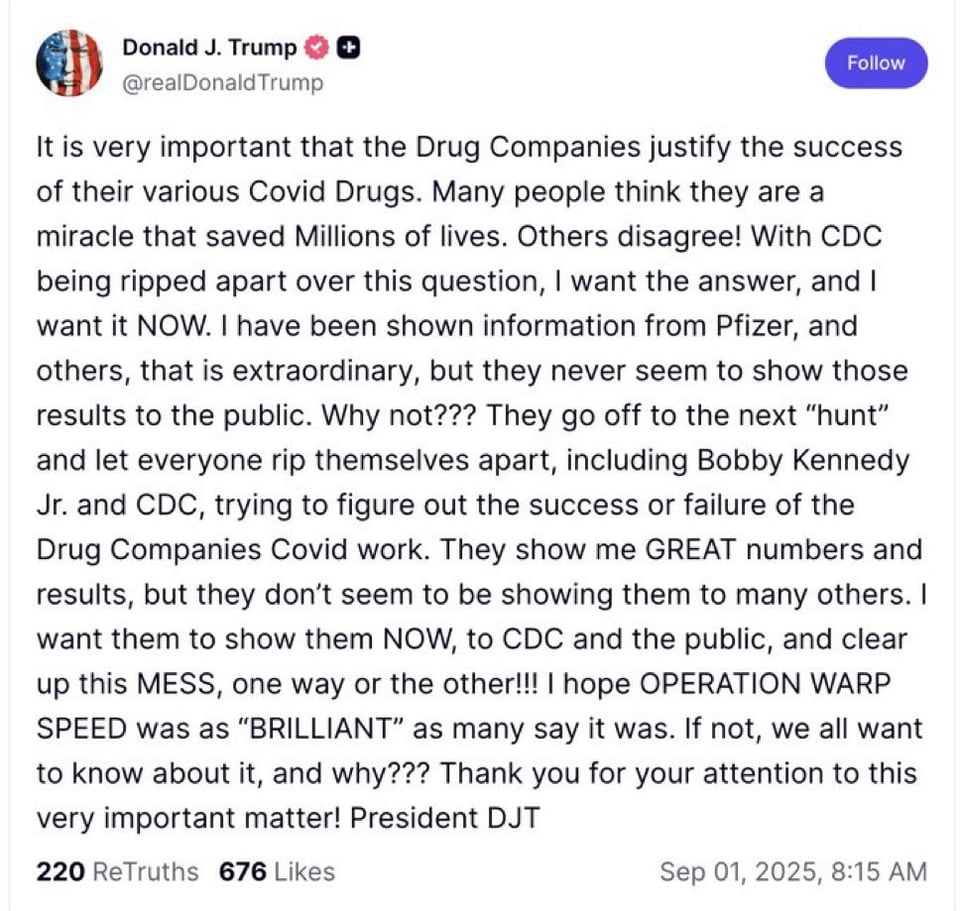
We face one Trump craziness after another.
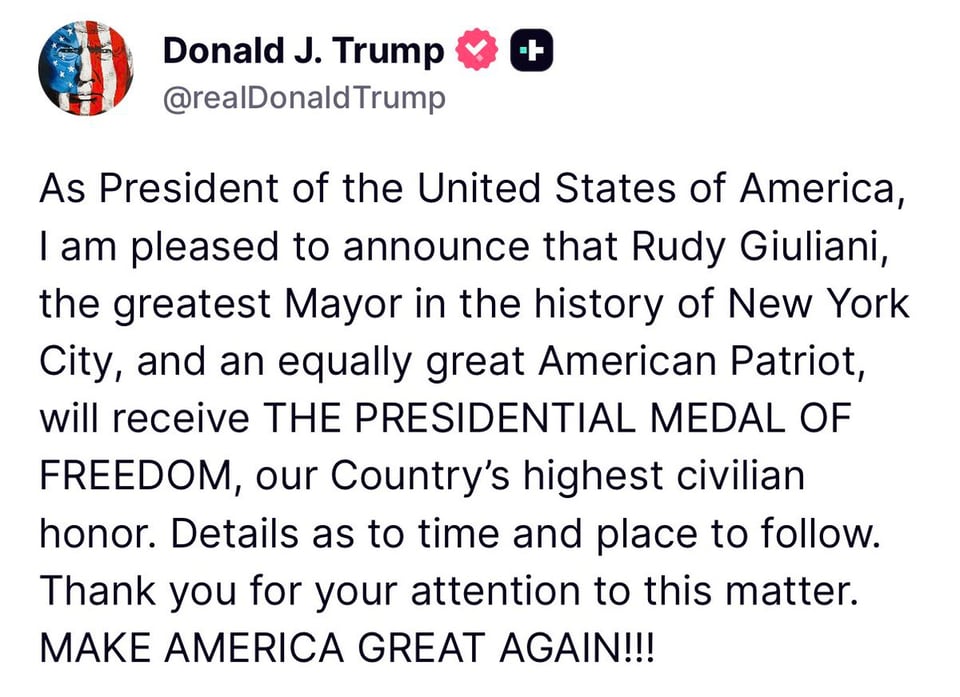
Labor Day around the web and the world.

First ever Boston Labor Day parade! This is is only HALF the crowd. Feels great out here! Solidarity! This is OUR city, OUR country, OUR world! pic.twitter.com/dJyRkQY0mM
— Sara Nelson (@FlyingWithSara) September 1, 2025
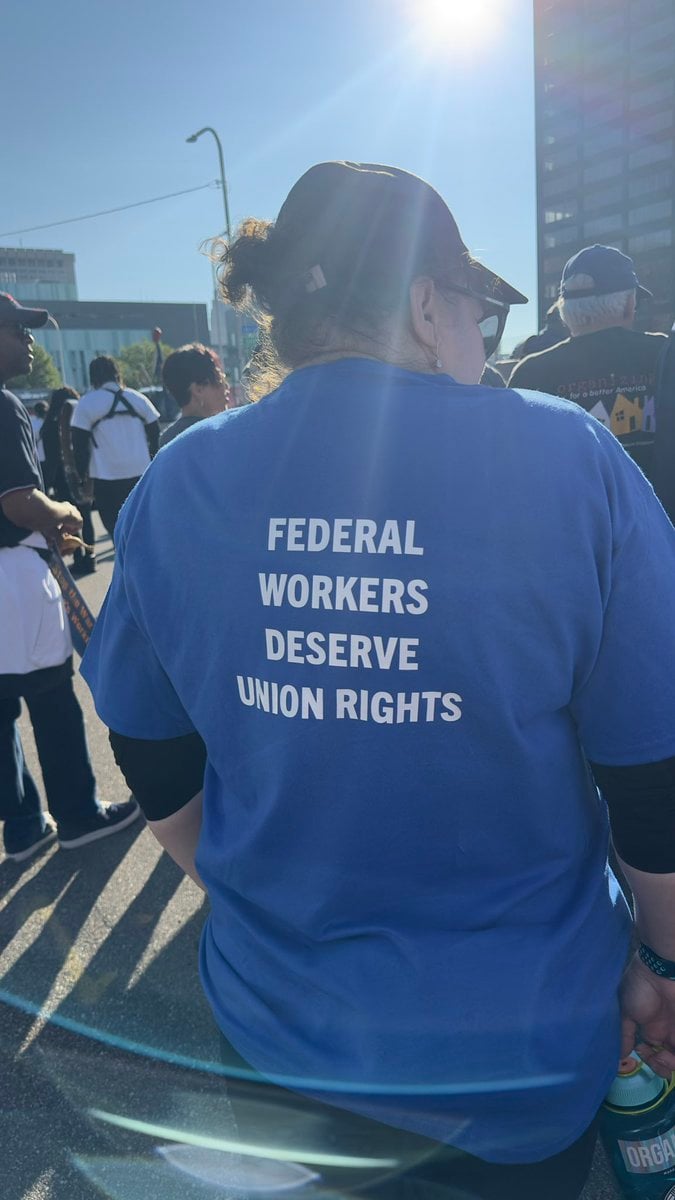
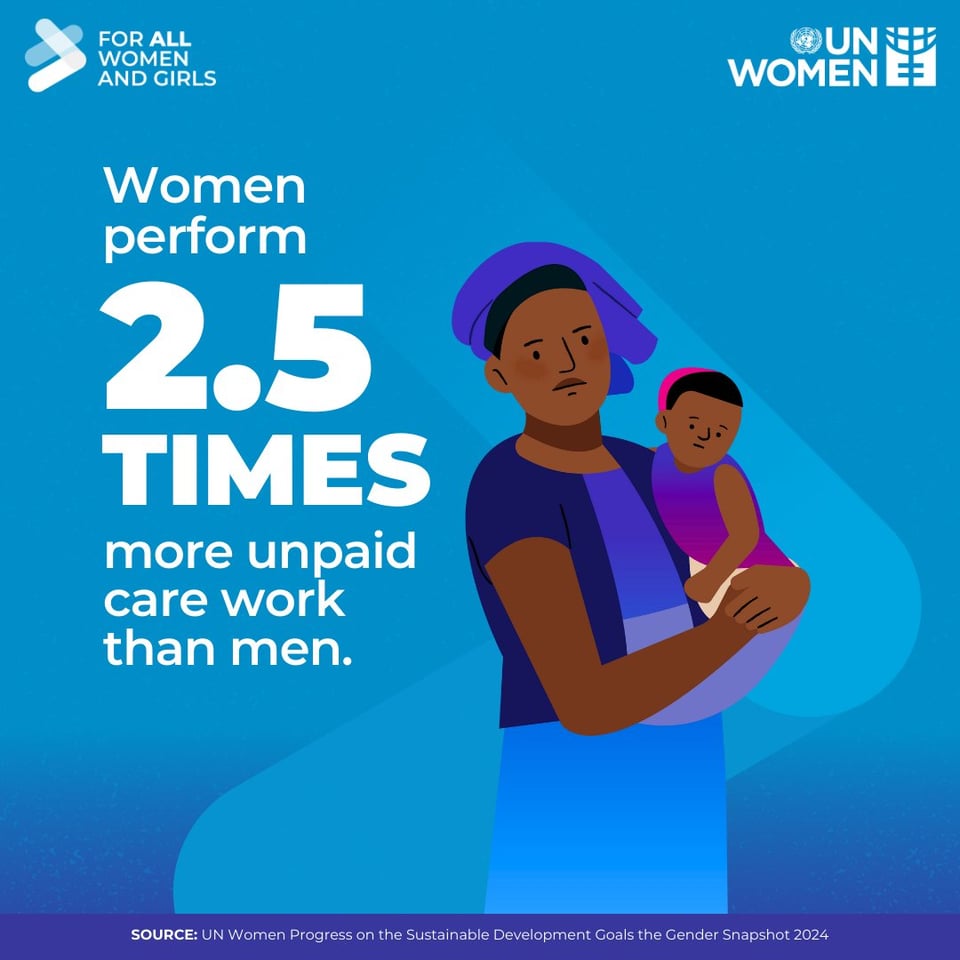

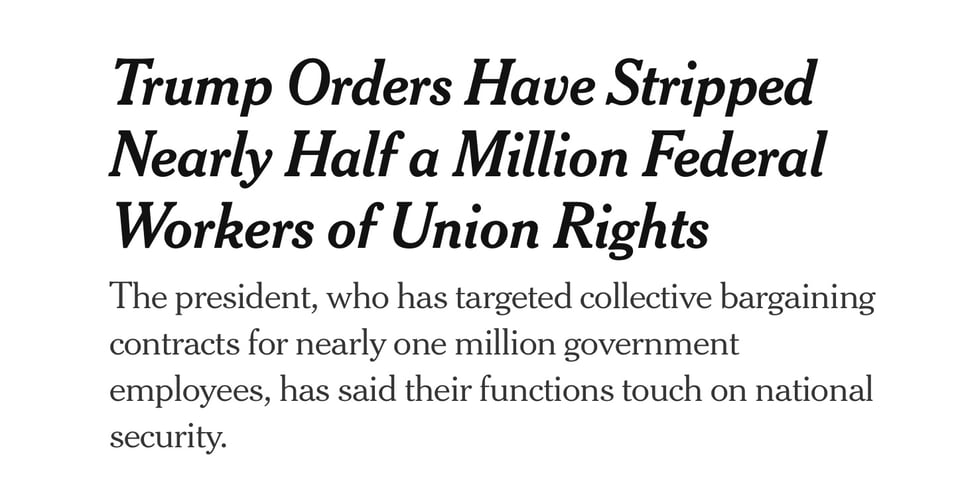
New York Times headline on Labor Day 2025
Trump’s War on Workers
Buried beneath the bluster is a systematic assault on labor.
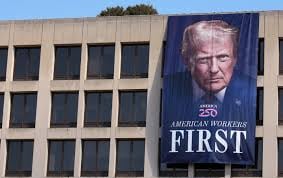
A photo of President Donald Trump is displayed on the side of the US Department of Labor on August 25, 2025, in Washington, DC.
Campaigning for president, Donald Trump assured workers that he would fight for them. “You’re going to have the American Dream back,” he said at his campaign rallies. “We’re going to be in the golden age.” His spokesperson now boasts that under Trump, workers already enjoy “increased job opportunities, better wages, and more bargaining power.”
Trump promises his tariffs will produce a renaissance of American manufacturing. Hs unpopular Republican budget bill—which slashes Medicaid and health care to fund tax breaks for the rich—is peddled as providing “working family tax cuts.”
Buried beneath the daily barrage of bluster is a systematic, multifront war on workers and their unions. Trump brandished his true colors when he paraded billionaires around him for his inauguration. Both Trump and the Republican party remain wedded to the trickle-down shibboleths of the executive suite: tax breaks for the rich and corporations, deregulation, and rigging the system against working people.
Ahead of Labor Day weekend, as Trump once more masquerades as a champion of workers, it is worth summarizing how extensive this assault has been in his first months in office.
Government Employees
Trump targeted federal workers from the start, scorning them as “crooked and dishonest.” His Office of Management and Budget director, the right-wing zealot Russell Vought, announced his goal was to have them “viewed as villains” and “put in trauma.”
Trump unleashed Elon Musk and his DOGE operatives to fire workers and shutter programs, trampling the law in the process. Trump brags that over 300,000 will have been fired or chased out by the end of the year. Trump’s Office of Personnel Management aims to install a spoils system, ordering that civil servants pledge loyalty to White House policies.
Unions
Unions—workers organizing and bargaining at the workplace—are central to how workers fare in our economy. Unionized workers enjoy better wages, working conditions and benefits. Widespread union membership counterbalances corporate power and lifts the wages of nonunion employees too. Not coincidentally, worker organizing rights have been under attack for decades—sadly, today only one in 10 workers has union representation.
Trump immediately set out to reduce that number. In his first days in office, he stripped 50,000 TSA workers of their union rights. In March, he moved to cancel the union rights of more than a million federal employees, in what Georgetown University labor historian Joseph McCartin called “by far the largest single action of union-busting in American history.”
Trump’s assault—an extreme version of what Ronald Reagan did when he infamously fired striking PATCO workers in 1981—now faces legal challenges. It affects career federal workers who work in every state helping veterans, supporting farmers, protecting our food supply, responding to disasters, and completing other critical tasks. More than 80 percent work outside DC, and nearly one-third are veterans.
“This administration’s bullying tactics represent a clear threat not just to federal employees and their unions, but to every American who values democracy and the freedoms of speech and association,” warned AFGE president Everett Kelley.
Trump then moved on to paralyze the National Labor Relations Board, the sole recourse for private-sector workers seeking to assert their rights under labor law, including the right to organize for better hours, wages, and working conditions. The board is tasked with protecting not only union workers but everyone who joins coworkers to improve their working conditions. Employees can’t directly sue their bosses for violating their organizing rights; they must instead file an Unfair Labor Practice charge for investigation by a regional NLRB office. The NLRB also plays a key role in the formation of new unions by conducting workplace elections—and, at least in theory, policing management’s conduct during those elections.
In his second week in office, Trump moved to disembowel the NLRB, firing member Gwynne Wilcox, along with NLRB General Counsel Jennifer Abruzzo. It was the first time a board member had been fired in history, and it not only violated the text of the National Labor Relations Act; it left the board without a quorum to make decisions. Corporations have seized on this development to delay and deny union certification, exemplified by lawyers for Jeff Bezos’s Amazon arguing that a landmark vote by Philadelphia Whole Foods workers to join UFCW is moot.
While Trump defended his action in court, his ally Elon Musk pursued his suit against the NLRB—Space X v. NLRB—arguing that the board itself is unconstitutional. In what soon became a pattern, the Supreme Court allowed Trump to proceed with his firing of Wilcox, and on August 19, the Fifth Circuit ruled the NLRB is likely unconstitutional in its current structure.
Attacking Wages and Benefits
Even as he challenges the foundations of labor law, Trump has struck directly at worker wages and benefits.
Trump’s Department of Labor is abandoning defense of the Biden rule that expanded the right to overtime pay for 4.3 million workers. The DOL also announced plans to stop enforcing a Biden-era rule that made it harder for employers to misclassify workers as independent contractors, potentially costing workers thousands of dollars each year.
Trump also continues to oppose raising the federal minimum wage for workers, which remains mired at $7.25 per hour—unchanged since 2009, and now below the official poverty level.
In addition, Trump’s spending bill—which lowers taxes on the rich while cutting health and food support for low-wage workers—represents an unprecedented transfer of wealth from working families to corporations and billionaires. The cumulative result of the act, according to the Congressional Budget Office, will be to reduce the income of the bottom 20 percent of families by an estimated 4 percent. In a May letter to Congress, the AFL-CIO calculated that Trump’s Medicaid cuts alone will lead to the loss of 880,000 jobs and increase overall healthcare costs for working families when providers begin passing their unreimbursed costs to employers, Taft-Hartley funds, and other payers.
Healthcare providers called the cuts an unsustainable blow for some of the smaller hospitals that communities rely on for critical care. “It’s very clear that Medicaid cuts will result in rural hospital closures,” warned Alan Morgan, the CEO of the National Rural Health Association.
Instead of using taxpayers’ money to empower workers, Trump has moved to strip protections from government contract workers. In March, he rescinded an executive order that raised the minimum wage for federal contractors, cutting these workers’ wages anywhere from 25 to 60 percent.
Although the median pay for home healthcare and personal aides was less than $17 an hour in 2024, Trump proposed to deprive millions of care workers—the vast majority women and disproportionately age 55 and older— of minimum-wage and overtime protections, setting them up for deep cuts in pay.
Employment for people with disabilities steadily increased under the Biden administration, which took steps to end the sub-minimum wage for workers with disabilities. Trump immediately moved to withdraw that rule, enabling employers to continue to pay workers with disabilities even less than the federal minimum wage.
Trump’s Gestapo-style worksite raids are terrorizing immigrant workers, detaining and deporting restaurant and hotel staff; farm, food processing and construction workers; day laborers; and even meal delivery drivers. Meanwhile his policies make it harder to get and maintain work permits, visas, and green cards, leaving millions of immigrant workers even more vulnerable to predatory employment practices.
Worker Safety and Health
An estimated 140,587 US workers died from hazardous working conditions in 2023, according to a new AFL-CIO report, while 5.2–7.8 million workers get hurt or sick on the job each year. Even as life expectancy declines among the working-age population, Trump has moved to weaken worker protections dramatically.
The Occupational Health and Safety Administration, tasked with enforcing workplace health and safety standards, has historically been understaffed. Under Biden, it would have taken OSHA 185 years to inspect each workplace under its jurisdiction once. Trump’s budget calls for a 30 percent reduction in inspections, making it once in every 266 years.
Trump also gutted the National Institute for Occupational Safety and Health, provides research on workplace safety standards, reducing its workforce from 1,400 employees to 150 and slashing its budget by 80 percent. Trump has even used executive orders to strike down specific measures to protect workers, including stalling the proposed Biden rule to regulate heat conditions in the workplace. Each year, 600 workers die from heat-related causes and nearly 25,000 are injured.
In April, the Trump administration announced that it would not enforce a Biden rule, 40 years in the making, to protect miners from dangerous silica exposure. And his administration weakened the ability of the Mine Safety and Health Administration to impose safety requirements related to roof falls and mine explosions.
Equal Employment Opportunity
In his obsession to obliterate diversity, equity, and inclusion, Trump is gutting civil rights protections for workers. In his first weeks in office, he fired two EEOC commissioners and the agency’s general counsel. He defunded the agency tasked with ensuring that federal contractors comply with equal employment opportunity laws and rescinded the executive order enforcing antidiscrimination protections. And his administration has threatened to go after corporations that voluntarily continue DEI protections—with some 60 percent jumping to eliminate mention of such programs in their annual reports.
Collateral Damage
In addition to these direct attacks on workers, their unions, wages, and rights, working people are being harmed by a broad range of Trump policies. For example, the administration moved to shutter the Consumer Financial Protection Bureau that protected consumers from various bank frauds and predation, effectively ending, as Matt Stoller reported, “any Federal enforcement of consumer protection rules for financial products,” opening the door to rampant fraud and cheating. The administration’s cuts of staff, resources, and authority at the Environmental Protection Agency will leave workers and their families exposed to more polluted water and air.
Even as Trump boasts of his American “revival,” early returns are bleak for workers. Wages aren’t keeping up with prices, and job growth has slowed. Health insurance costs in the Affordable Care marketplace will spike an estimated 18 percent next year. Household electric bills are up 10 percent, largely thanks to Trump’s attacks on renewable energy. Predatory monopoly pricing will spread with companies essentially given a free pass from anti-trust enforcement. Student loan burdens will leave millions of workers in default, leading to the garnishing of wages.
Trump’s attacks on workers are not an accident—they’re the plan. Employers are being empowered to act lawlessly toward their workers. Unions are being stripped of the legal structure that protected their existence. Immigrant workers are abused, hunted, and deported. Women and minorities will suffer from discrimination at rates not seen since the civil rights revolution. Workers’ families are shouldering higher costs for food, healthcare, and energy. Corruption and financial fraud will spread.
This assault, not part of Trump’s supposed mandate, is not popular. Seventy percent of Americans support unions, Most Americans have even turned against Trump’s immigration raids. Not surprisingly, as Trump’s assault on workers escalates so too do his increasingly frenetic efforts to distract, dissemble, and divert. He shamelessly lies about his intentions and his triumphs, blaming others for what goes wrong while preening himself, the cockroach billionaire, as the worker’s champion.
One thing is clear: Neither the Congress nor the courts will save working people. Once more, workers themselves must rise and turn the tide together. (The New Republic).
** Honoring the day as in the past.**
Today we celebrate American workers – the heart and soul of our nation. Unions built the middle class. And the middle class built this country. Happy Labor Day, America. pic.twitter.com/4kLl6jnYHR
— Joe Biden (@JoeBiden) September 1, 2025
The damage that Trump has done to the United States internationally.
Modi joins hands with Xi and Putin in message to Trump
Facing tariffs and insults from President Trump, Indian Prime Minister Narendra Modi had a far friendlier interaction on Monday with his Russian and Chinese counterparts during his first visit to China in seven years.
The big picture: Successive U.S. presidents have aggressively courted India as a counterweight to China. Trump is actively trying to drive a wedge between India and Russia while seeking to gradually peel Russia away from China. So the image of all three leaders literally holding hands is, at the very least, a symbolic blow.
Driving the news: Modi and Russian President Vladimir Putin entered the Shanghai Cooperation Organization summit hand-in-hand and immediately formed a tight circle with Chinese President Xi Jinping — warm smiles on display for the press.
Xi gave a speech denouncing "Cold War mentalities" and "bullying," without mentioning Trump's name.
Modi and Putin shared a limo ride and spoke one-on-one for nearly an hour. Modi later told Putin, "1.4 billion Indians are waiting with excitement" to welcome him later this year.
Xi and Modi also met on Sunday, with readouts from both of the neighboring giants stressing they are "partners," not "rivals."
Between the lines: From Modi's perspective, the pageantry seems a clear attempt to demonstrate that India is a powerful player with influential partners.
Trump's 50% tariffs, doubled last week over India's continued purchases of Russian oil, have sparked outrage in the country. So have insulting comments from Trump and some on his team.
Trump doubled down on Monday, calling U.S. trade with India "a totally one sided disaster."
Modi has signaled India won't stop buying oil from Russia, and has moved to patch up ties with Xi, potentially undercutting more than a decade of U.S. efforts to team up with India in its competition with China.
Reality check: While Sino-Indian relations seem to have thawed, they're hardly warm. Deadly 2020 border clashes still loom large, along with disputes over technology and regional influence.
Some analysts also think the "relationship without limits" between China and Russia will be undermined over time by their growing power imbalance, anxiety over their shared borer, and differences on regional issues like North Korea.
The bottom line: For now at least, the Trump administration's desire to put distance between the three powers is not bearing fruit.(Axios)
One more thing.
Let’s not forget this too.
Trump’s narcissism and craziness is at the center of our country’s new split with India.
Prime Minister Narendra Modi of India was losing patience with President Trump.
Mr. Trump had been saying — repeatedly, publicly, exuberantly — that he had “solved” the military conflict between India and Pakistan, a dispute that dates back more than 75 years and is far deeper and more complicated than Mr. Trump was making it out to be.
During a phone call on June 17, Mr. Trump brought it up again, saying how proud he was of ending the military escalation. He mentioned that Pakistan was going to nominate him for the Nobel Peace Prize, an honor for which he had been openly campaigning. The not-so-subtle implication, according to people familiar with the call, was that Mr. Modi should do the same.
The Indian leader bristled. He told Mr. Trump that U.S. involvement had nothing to do with the recent cease-fire. It had been settled directly between India and Pakistan.
Mr. Trump largely brushed off Mr. Modi’s comments, but the disagreement — and Mr. Modi’s refusal to engage on the Nobel — has played an outsize role in the souring relationship between the two leaders, whose once-close ties go back to Mr. Trump’s first term. (To read the whole article in the New York Times, click on the blue link above or here.)
Trump’s favorite Russian had a busy weekend too.
Fortunately, this piece of his plan didn’t turn out as he hoped.
Yesterday, Ursula von der Leyen’s lost GPS signals while approaching Bulgaria
— Tymofiy Mylovanov (@Mylovanov) September 1, 2025
“The whole airport area GPS went dark” said one of the officials
Russian jamming blinded navigation systems, forcing the pilot to circle for an hour and land manually using paper maps. - FT
1/ pic.twitter.com/q3GoCKe2Fj
What did you do this weekend?
What color is your hair?
If you are a red-head, you might have gone to the southern Dutch city of Tilburg to join thousands of their redheads from all over the world gathered for a once-a-year festival to celebrate their flaming hair.




Or you might have gone to Flushing for the US Open to cheer for the Italian tennis player, Jannik Sinner, the #1 male tennis player in the world, who usually hides his curly red locks under a hat.


Sinner won his round of 16 match 6-1,6-1,6-1.
I was happy for him but even happier to see 22 year old Leylah Fernandez and her partner, 45 year old Venus Williams, advance to the quarterfinals in Women’s Doubles.
